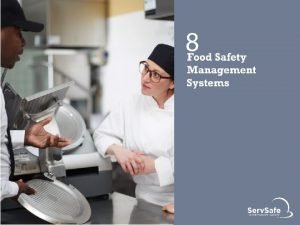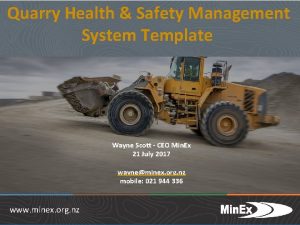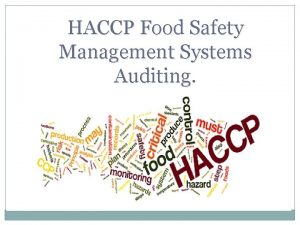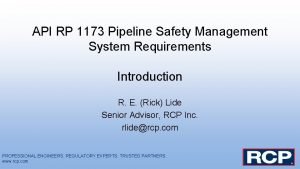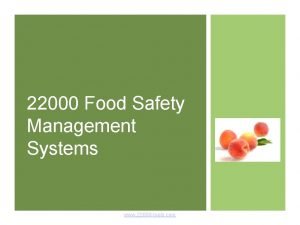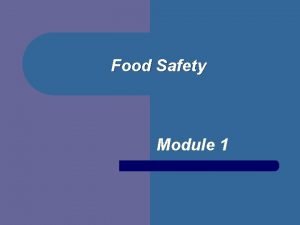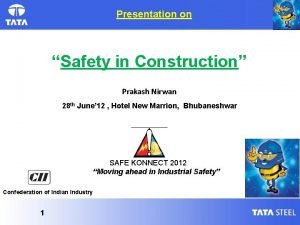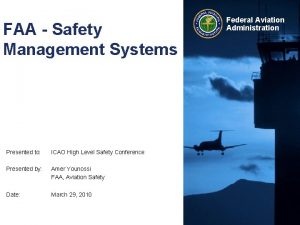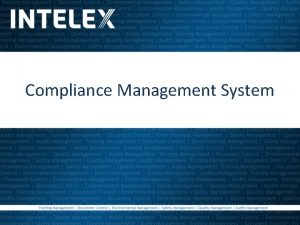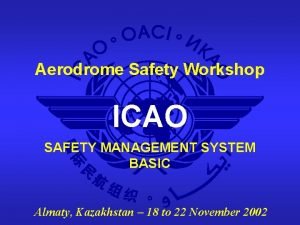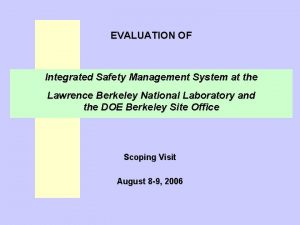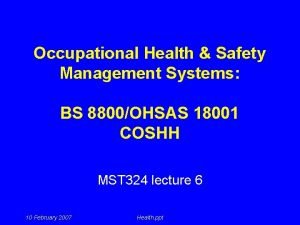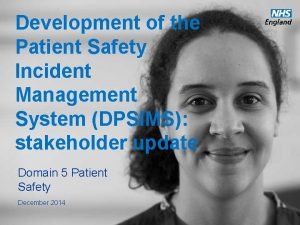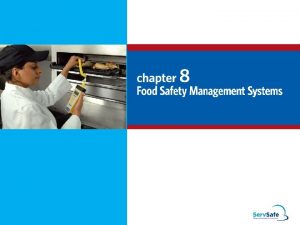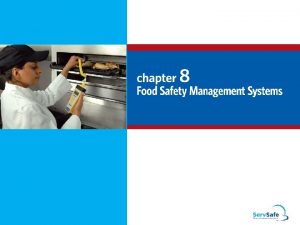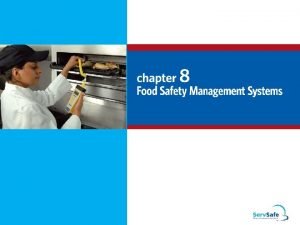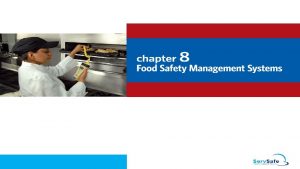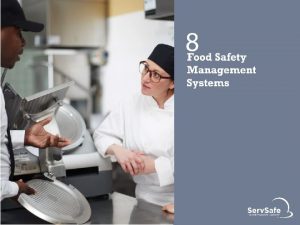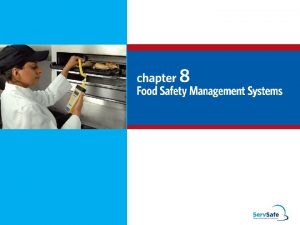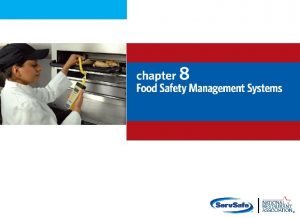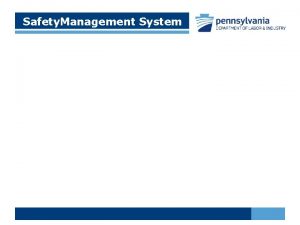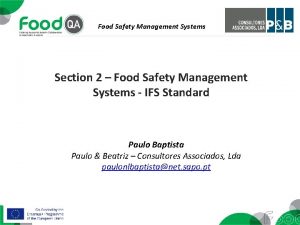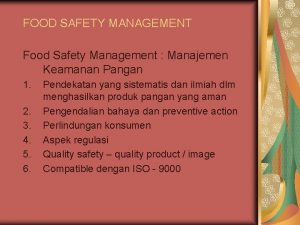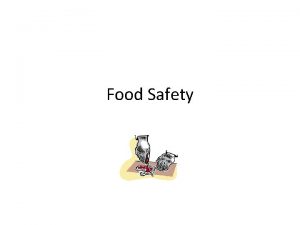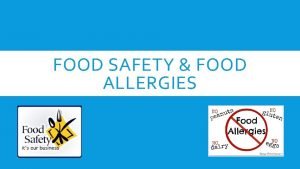Food Safety Management Systems Food safety management system



















- Slides: 19


Food Safety Management Systems Food safety management system: 8 -2 l Group of practices and procedures intended to prevent foodborne illness l Actively controls risks and hazards throughout the flow of food

Food Safety Programs These are the foundation of a food safety management system: 8 -3 Personal hygiene program Food safety training program Supplier selection and specification program Quality control and assurance program

Food Safety Programs These are the foundation of a food safety management system: 8 -4 Cleaning and sanitation program Standard operating procedures (SOPs) Facility design and equipment maintenance program Pest control program

What Do You Think? A cook forgot to wash his uniform before starting work. Could this cause a foodborne illness? A. Yes B. No Why? This employee is practicing poor personal hygiene. This is a common risk for foodborne illness. 8 -5

What Do You Think? A chicken breast was cooked to 165ºF (74ºC). Could this cause a foodborne illness? A. Yes B. No Why? Failing to cook food correctly is a risk for foodborne illness. But, this chicken was cooked to the correct temperature. 8 -6

What Do You Think? A cook served rice at 120ºF (49ºC) from a holding unit. Could this cause a foodborne illness? A. Yes B. No Why? The rice should be held at 135ºF (57ºC) or higher. Holding food at incorrect temperatures is a risk for foodborne illness. 8 -7

What Do You Think? A manager bought steaks raised and sold from a private home. Could this cause a foodborne illness? A. Yes B. No Why? The steaks are not from an approved source. Purchasing food from unsafe sources is a risk for foodborne illness. 8 -8

What Do You Think? A cutting board was used to prep fish and then fruit salad. Could this cause a foodborne illness? A. Yes B. No Why? The cutting board may have become contaminated with pathogens from the fish. Using contaminated equipment is a risk for foodborne illness. 8 -9

Active Managerial Control Focuses on controlling the five most common risk factors for foodborne illness: 1. Purchasing food from unsafe sources 2. Failing to cook food correctly 3. Holding food at incorrect temperatures 4. Using contaminated equipment 5. Practicing poor personal hygiene 8 -10

Active Managerial Control There are many ways to achieve active managerial control in the operation: 8 -11 l Training programs l Manager supervision l Incorporation of standard operating procedures (SOPs) l HACCP

Active Managerial Control To keep food safe: 8 -12 l Practice active managerial control throughout the flow of food l Anticipate potential foodborne-illness risk factors and control or eliminate them l Apply what you have learned in Serv. Safe l Monitor the flow of food l Provide staff with the proper tools to make sure food is safe (e. g. , procedures and training)

Implementing Active Managerial Control To implement active managerial control: 1. Identify risks 2. Monitor 3. Corrective action 4. Management oversight 5. Training 6. Re-evaluation 8 -13

Active Managerial Control 1. Identify Risks: l Find and document potential foodborne illness risks in the operation l Identify the hazards that can be controlled or eliminated 2. Monitor: 8 -14 l Food will be safe if managers monitor critical activities l Identify where employees must monitor food safety requirements o When temperatures must be taken o How often sanitizer concentrations should be tested

Active Managerial Control 3. Corrective Action: l Take appropriate steps to correct improper procedures or behaviors o If a sanitizer level is too low, increase the concentration level 4. Management oversight: l 8 -15 Verify that all policies, procedures, and corrective actions are followed

Active Managerial Control 5. Training: l Ensure employees are trained to follow procedures and retrained when necessary 6. Re-evaluation: l 8 -16 Periodically assess the system to make sure it is working correctly and effectively

The FDA’s Public Health Interventions The FDA provides recommendations for controlling the common risk factors for foodborne illness: 8 -17 l Demonstration of knowledge l Staff health controls l Controlling hands as a vehicle of contamination l Time and temperature parameters for controlling pathogens l Consumer advisories

HACCP The HACCP approach: 8 -18 l HACCP is based on identifying significant biological, chemical, or physical hazards at specific points within a product’s flow through an operation l Once identified, hazards can be prevented, eliminated, or reduced to safe levels

HACCP To be effective, a HACCP system must be based on a written plan: 8 -19 l It must be specific to each facility’s menu, customers, equipment, processes, and operations l A plan that works for one operation may not work for another
 Active managerial control software
Active managerial control software Food safety management system template
Food safety management system template Key elements of food safety management system
Key elements of food safety management system Api 1173 training
Api 1173 training Food safety food security
Food safety food security Unit 2 food food food
Unit 2 food food food Grazing food chain diagram
Grazing food chain diagram 22000-tools.com
22000-tools.com Food safety management arkansas
Food safety management arkansas Decision support systems and intelligent systems
Decision support systems and intelligent systems Principles of complex systems for systems engineering
Principles of complex systems for systems engineering Embedded systems vs cyber physical systems
Embedded systems vs cyber physical systems Engineering elegant systems: theory of systems engineering
Engineering elegant systems: theory of systems engineering Hard barrication for excavation
Hard barrication for excavation Safety management system faa
Safety management system faa Intelex safety management system
Intelex safety management system Aerodrome safety management system
Aerodrome safety management system Integrated safety management system
Integrated safety management system Bs 8800
Bs 8800 Patient safety incident management system
Patient safety incident management system
